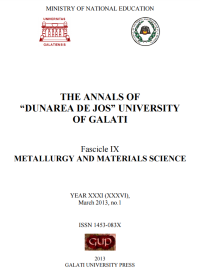Regeneration of Used Engine Lubrication Oil by Solvent Extraction. The Solvent Influence on Oil Ratio
Abstract
Huge amounts of used lubricating oils from automotive sources are disposed of as a harmful waste into the environment. For this reason, means to recover and reuse these wastes need to be found. Problems arising from acid treatment include environmental problems associated with the disposal of acid sludge and spent earth, low product yield (45–65%) and incomplete removal of metals.
The processes of re-refining of used lubricating oils depend greatly on the nature of the oil base stock and on the nature and amount of contaminants in the lubricant resulting from operations. The study was carried out on a sample of 15W40 type of used oil collected from one automobile. The re-refining process of used oil consists of dehydration, solvent extraction, solvent stripping and vacuum distillation. This study aims to investigate a process of solvent extraction of an alcohol–ketone mixture as a pre-treatment step followed by vacuum distillation at 5 mmHg. The primary step was conducted before the solvent extraction that involves dehydration to remove the water and fuel contaminants from the used oil by vacuum distillation. The solvent extraction and vacuum distillation steps were used to remove higher molecular weight contaminants. The investigated solvent to oil ratios was 2, 3, 4, 5 and 6. The solvent composition is 25% 2-propanol, 50% 1-butanol and 25% butanone or methyl ethyl ketone (MEK). The percentage of oil recovery for the solvent to oil ratio of 6:1 is further improved, but for the ratio values higher than 6:1, the operation was considered economically not feasible. Finally, the rerefined oil properties were compared to the commercial virgin lubricating oil properties.
Downloads
References
[2]. Ostrikov V.V., Prokhorenkov V. D., Nagornov S. A. - Industrial Ecology. Waste-Free Technology for Processing Used Lubricating Oil, Chemical and Petroleum Engineering, v.39, n, 5-6, p. 292-297, (2003).
[3]. Whisman M.L., Reynolds J.W., Goetzinger J.E. and Cotton F.O. - Re-refining makes quality oils, Hydrocarbon Processing October, p141-145, (1978).
[4]. Ostrikov V.V., Prokhorenkov V.D. - Waste-free technology for processing used lubricating oil, Chemical and Petroleum Engineering v. 39, p. 5-6, (2003).
[5]. Bhaskar T., Azhar Uddin M., Muto A., Sakata Y., Omura Y., Kimura K., Kawakami Y. - Recycling of waste lubricant oil into chemical feedstock or fuel oil over supported iron oxide catalysts, Fuel v. 83, p. 9-15, (2004).
[6]. Snow R.J., Delaney S.F. - Vacuum distillation of used lubricating oil, Chemeca, 77, p. 14-16, (1977).
[7]. Awaja F., Pavel D. - Design Aspects Of Used Lubricating Oil Re-Refining, Elsevier Science Publisher B.V., Amsterdam, (2006).



